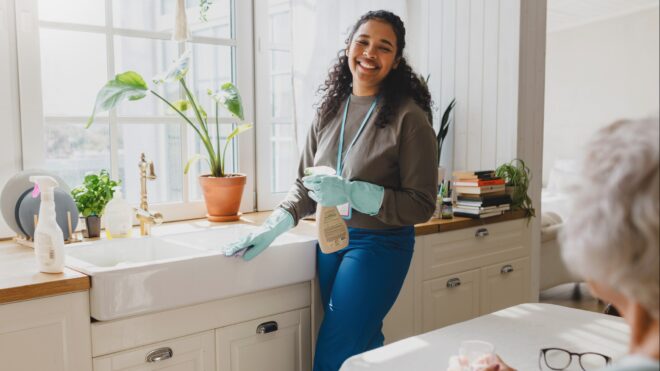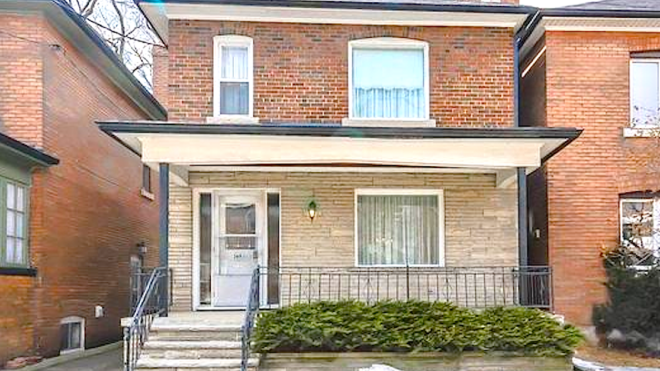
If there’s one gardening project that anyone can get behind, it’s a terrarium. Now that I’ve officially made my first one, I can confidently tell you that they feel more like a craft project than a gardening endeavor.
You may not believe me, because terrariums look incredibly fancy and cool and intimidating. But I promise they are much simpler than they seem. That’s because any basic terrarium can be built using the same simple formula. You pour rocks, soil, charcoal, and sometimes sand into a container. Stick some plants in there. Boom! It’s a terrarium.
By design, terrariums don’t require much effort to take care of them. They’re usually filled with low-maintenance, slow-growing plants, and they don’t need to be watered very often. In most cases, the plants will stay happily in the terrarium for anywhere from a few months to a couple of years — basically, until the plants outgrow their container. In some closed terrariums, the plants can live in there indefinitely.
Terrariums can also range from really tiny — there are miniature ones that are small enough to hang on a necklace! — to the size of a small aquarium, so they’re great for plant lovers with limited indoor space.
Basically, there is no reason not to make a terrarium. None. And so, recently, I made one for the very first time.
I have approximately half of a green thumb — I generally know what I’m doing, but I can be absent-minded and straight-up neglectful. The plants that work best in my care are those that can tolerate a little neglect. A terrarium full of succulents seemed like the perfect candidate. The process was incredibly straightforward, and I’m really happy with the result!
I made a succulent terrarium with four plants in a 1-gallon plastic fish bowl. Here’s how you can make your own.
Getting Started: Picking Plants

Taking care of a terrarium is easy, as long as you choose the right plants. There’s no need to reinvent the wheel here. Certain plants are incredibly popular in terrariums for a reason, and there are plenty of them to choose from!
The plants that work best in terrariums are generally small, slow-growing, and easy to care for. They range from mosses to ferns to cacti.
Importantly, each terrarium must include only plants that have the same environmental needs. You’re basically creating a miniature habitat here, so everything has to be in harmony. If you put plants that have different needs in the same container, one of them will end up unhappy.
Instead of choosing specific plants from the outset, I found it made more sense to envision what type of environment I wanted to create.
Did I want a desert-like terrarium, with lots of sand and cacti? Did I want a peaceful garden vibe with lots of rocks and succulents? Or did I want my terrarium to look like a miniature rainforest, humid and filled with moss and leafy ferns? Or perhaps a minimalist terrarium with simple rocks and air plants?
So many options, so little time.
After some way-too-long mulling, I decided to go with the second option: rocks and succulents. That meant sacrificing other plants that I love (mosses and air plants) — but I can always make more terrariums!
From there, it’s easier to choose specific plants. Cacti, succulents, and air plants are pretty straightforward — just choose small ones that won’t touch the sides of the glass. For a rainforest feel, you can build a terrarium with humidity-loving plants, like ferns, moss, spiderwort, baby’s tears, African violets, and peperomia.
Choosing a Container

Once you’ve chosen your plants, pick a container.
Terrarium containers come in all shapes and sizes, and they can be made of either plastic or glass. Plastic is cheaper and less likely to break, but it also scratches and smudges more easily. If you go with glass, you could potentially use a wide variety of recycled containers, like a coffee pot or old vase, rather than buying a new one.
Terrariums can also be either open or closed. Open terrariums don’t have a lid, so they have much more air circulation. They’re ideal for plants that like dryness and air circulation, like cacti, succulents, and air plants.
Closed terrariums, on the other hand, become quite humid inside, so they’re great for tropical plants that love moisture and shade, like ferns and mosses. Closed terrariums develop their own water cycle, which is so cool! Plus, they only need to be watered very rarely, when the soil begins to dry out.
I chose an open, plastic terrarium for my succulents. In other words, I bought a plastic fishbowl for $5.
Finding Terrarium Materials

I used the following materials to build my terrarium:
- Soil. Unless your terrarium will house only air plants, which don’t require soil, you’re definitely going to need some dirt. Make sure to buy soil that’s appropriate for your specific plants.
- Rocks. Rocks and pebbles are used for drainage at the bottom of the terrarium.
- Charcoal. Activated charcoal helps absorb toxins and filter the soil in the terrarium, which is a must in a container without any drainage holes.
- Decorations. This is optional, but you can use pretty rocks, figurines, preserved moss, and any other decorations you like.
That’s it! Some people also add sand to their terrariums, either as part of the drainage layer or along with the soil if they’re planting desert plants.
I bought all of these materials as part of a kit on Amazon, because I’m a millennial and it was the most efficient and cost-effective option. You can, however, buy all of these items individually at a gardening center.
Step 1: Add Rocks/Pebbles to Container

First, I added an inch or two of small rocks to the bottom of the fishbowl.
Terrariums don't have any actual drainage holes like most plant pots do, so the rocks provide a place for the water to drain from the soil.
Step 2: Add Thin Layer of Soil

Next, I added a thin layer of soil on top of the rocks.
Step 3: Add Layer of Activated Charcoal

And then I added a layer of activated charcoal on top of that.
Step 4: Add More Soil

Next, I added the rest of the soil in my kit. It was maybe a few more inches — just enough to hold my plants.
The container should be about one-third full at this point, and most of that space should be taken up by soil.
Step 5: Add Plants

Time for the fun part — placing the plants!
First, gently remove each plant from its container by turning the container sideways and gently squeezing it to loosen the sides. You want to take all of the soil and roots with you in one piece.

Then, pick a spot in the dirt for the plant to go and carve out an appropriately sized hole. Place the plant in it and gently pack the soil back down to secure it into place.

It can be a bit tricky to do all this through the small opening in the fishbowl without breaking a leaf or two, especially if you change your mind and need to rearrange things, like I did. I definitely broke a leaf or two. But it's OK — the plants will survive, and those leaves can actually grow into new plants!
On the other hand, this is why you don't want to choose a container with too narrow of an opening.
Step 6: Add Decorations

Once your plants are in place, it's time to add your decorations.
As you can see, I added something that looks like moss but is actually just decorative — it's dead, preserved moss that's been dyed green. Real moss wouldn't work well in a container with succulents because they have completely different environmental needs.

I also added some decorative rocks from my kit, as well as a couple pretty crystals from my collection.
Some people add tiny figurines, dinosaurs, or even small houses to create a diorama of sorts! The tiny terrarium world is your oyster.
All Finished!

Finally, it was complete! The entire process took me maybe 30 minutes, and… I love it.

Now, how do you keep a succulent terrarium alive? Mine hasn't been around long, so I can't speak from too much experience, but here's what I've gleaned from others.
You should keep the terrarium in a brightly lit area, but away from direct sunlight, because the glass will magnify the heat and cook your plants.
You should also water your terrarium very conservatively — like, use a dropper or a teaspoon to measure it out and wait until the soil is completely dry to water it again. You may only need to water monthly or so. Overwatering will annihilate your succulents in no time, and watering less often is less work for you — a win-win!
That said, other types of terrariums are quite different and may need more or less water. Take into account the exact needs of your plants and adjust accordingly.
With any luck, your plants will thrive in there and eventually outgrow the small container, in which case you can take them out and start all over. Whoo!




